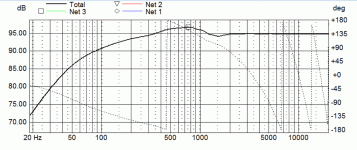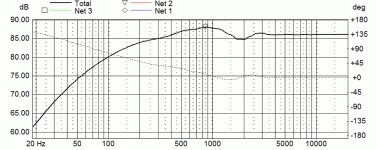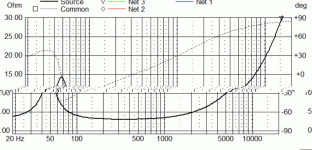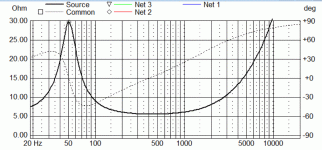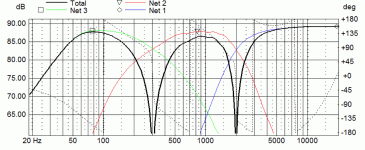btw the measurement gear i currently have
1. Dayton emm6
2. focusrite 2i2
3. multimeter
software
holmimpulse, REW
may be able to get access to ARTA
1. Dayton emm6
2. focusrite 2i2
3. multimeter
software
holmimpulse, REW
may be able to get access to ARTA
Sell.
Even if you lose money on this sale, you will not waste even more money on this speaker.
Even as a technical learning opportunity, the only lesson you probably will take away is that you don't want to battle with a complex crossover ever again, there is good reason why there are so many full range speaker enthusiasts.
Even if you lose money on this sale, you will not waste even more money on this speaker.
Even as a technical learning opportunity, the only lesson you probably will take away is that you don't want to battle with a complex crossover ever again, there is good reason why there are so many full range speaker enthusiasts.
Hi Joji,---
Active:
1. Get rid of both passive XO
2. Procure MiniDSP for high/mid/woofer XO
3. Procure Multichannel DAC
4. Procure Multichannel preamp/power amp
5. Return expensive stereo amp 🙁
6. Return expensive stereo DAC preamp 🙁
The active option also involves lots of measurement and tuning.
---
Obviously your engineer's brains is overrevving! Going active for mains is not that complicated. This is how I do it (multichannel system):
- my old AV reveiver/amp is the preamp and source selector for 5.1 and stereo sources CD, FM radio, TVtuner/HDD, DVD etc. analog and digital sources
- my old AV receiver/amp drives center and rear channel speakers (and sub if I want to)
- my old AV receiver/amp feeds a minidsp 4x10Hd with analog stereo signal taken form the LR pre-outs. This way it makes DD or Prologic dsp adjustments if I ask it to. If I bypass it's dsp, signal is original stereo (pure direct)
- minidsp acts as 4-way stereo crossover/eq/delay controller, it feeds two classD stereo amplifiers per speaker. D-class have very low idle current and run cool, I have power on 24/7 in minids and amps - they are invisible to the end user!
More advice here by John Reekie Refining a 4-way open-baffle speaker with the miniDSP 2×4
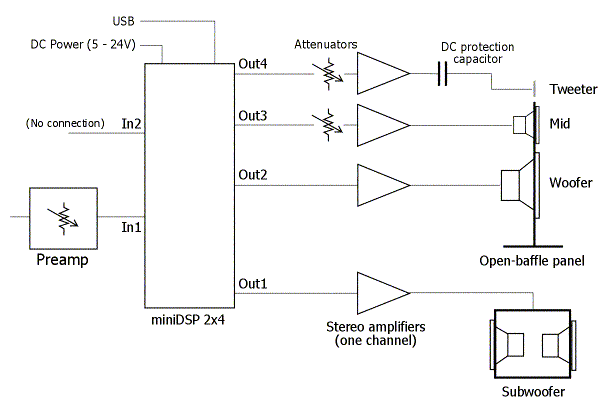
(output attenuators are not needed!)
Last edited:
Some more hints about minidsp-hybrid systems,
- measuring system is needed, we are using acoustic measurements to set dsp parameters to get good acoustic co-operation of each driver
- the subwoofer's amp and xo add their own delay, I recommend using minidsp to control it, bypass it's xo. You wouldn't believe how well a subwoofer integrates with minidsp - check step response!
-minidsp adds processing delay. If you use multichannel system, you must set excess delay (distance) for center and rear channels
-
Yes minidsp and more amplifiers adds costs and is a learning challenge. However I am sure that designing a better new passive loudspeaker (xo) is even more challenging.
Minidsp unit and amplifiers have very good retail value if you ever convert to SET-amps and fullranges!
- measuring system is needed, we are using acoustic measurements to set dsp parameters to get good acoustic co-operation of each driver
- the subwoofer's amp and xo add their own delay, I recommend using minidsp to control it, bypass it's xo. You wouldn't believe how well a subwoofer integrates with minidsp - check step response!
-minidsp adds processing delay. If you use multichannel system, you must set excess delay (distance) for center and rear channels
-
Yes minidsp and more amplifiers adds costs and is a learning challenge. However I am sure that designing a better new passive loudspeaker (xo) is even more challenging.
Minidsp unit and amplifiers have very good retail value if you ever convert to SET-amps and fullranges!
The OP would seem to have a speaker made from a Selah RC4 kit but using an odd baffle.
Several posters including myself have doubts about the combination of a large metal midrange and a small ribbon tweeter in a 3 way with significant output from decent sized woofers. Are you happy with this aspect of your speakers?
Andy, in ALL my interactions with Rick (BTW Rick was recommended to me by someone at Salk - maybe even Jim Salk himself - when I asked Salk for a speaker kit sans cabinet and they could not do it) Craig he has been super helpful and a gentleman of the highest order. Hence this is what I suspect -
- Rick must have offered the speaker design to some guy who built it himself just like I did
- The builder then went nuts and figured 3" baffle is better than 1" baffle and forgot about back-wave and chamfering and all that.
- This builder (might even be the Solst1ce guy I saw on Audiogon - OP can confirm) then sold the speaker to the OP.
Hence in my view, Rick has nothing to do with the challenges the OP now faces with this particular build. Rick if you are viewing this, sorry about bringing your name into this.
The W15CY cone is harder than the W16NX cone and hence has should not be used beyond 2.5k (preferably 2k). I hence used the NeoX series of tweeters which has a lower Fs and can go as low as 2k (3.0 version) or 2.5k (2.0 version). I would recommend the OP try this option as it has worked nicely for me.
My speakers are ported and the box designed as such. I am not very happy with side firing woofers (phase issues) even since I heard the first NHT3.3 and even later with the Audio Physic models. I happen to know Audio Physic models well as they use Wavecor drivers made by Allan. Hence I requested that my speakers leave the subwoofer out and I use a TC 15" LMR front sub and a SEAS ROY 10" rear sub for HT sub duties. For plain vanilla audio use I don't need subs. Dual 8"s give me enough bass.
Thanks Nevin. I did come across you excellent build thread when considering these speakers 🙂, was one of the factors which convinced me to go ahead with the deal.
Thanks, and sorry for bringing Rick's name into this.
Here are current options and steps as they stand.
Jojip, I am not at liberty to discuss Rick's designs without his permission.
Because I was building my speakers in India, he gave me a lot of information about them. I am rushing to a meeting now and will try and assist in a manner that does not affect the information I have. Hope you understand. Thanks.
1. Measure in room responses of the current speaker/drivers
2. Try to unmounts crossover boards and reverse engineer.
Passive 1:
1. Change from ribbon to seas dome tweeter
2. Redesign the high/mid XO
3. Leave woofer design as is
Active:
1. Get rid of both passive XO
2. Procure MiniDSP for high/mid/woofer XO
3. Procure Multichannel DAC
4. Procure Multichannel preamp/power amp
5. Return expensive stereo amp 🙁
6. Return expensive stereo DAC preamp 🙁
This is how I do it (multichannel system):
Ok, Jojip,
I got back from my meeting. I cant edit my old post anymore so this is what I would do.
1. first get the measurements of your existing system at your listening position(s).
2. consider changing ONLY the tweeter and in my view a change to the NeoX tweeter would require the least modification to the original crossover (and Rick might even be able to help with that).
One you complete this step examine the results and then proceed.
My system is pretty simple. It serves 2 uses. (a) 2 channel audio and (b) Hometheater.
In 2 channel audio the CD player is connected directly to the Yamaha integrated amplifier and to the speakers (bi wired using A and B terminals). The Yamaha allows me to drive the front subwoofer via a pre out if I feel the need to. I have not needed to regularly. My music ranges from Blues, to Jazz, to Rock and occasionally to some Heavy Rock (some people even call it metal - Black Sabbath for example).
In HT/gaming mode the HT input devices (XBMC, BluRay, PS3, Wii, TV Set top boxes) are all connected to my Onkyo AVR. The AVR then uses the Yamaha as a power amp (main direct mode) to drive the front speakers and drives only rear and front channels. The Subwoofers are driven from the AVR's sub out.
Any DSP (time delay) is done by the Onkyo (my first choice was the Yamaha 3020 but it was unavailable in India and after waiting for 5 months I finally broke down and got the Onkyo).
Thanks for the response but it would seem your speaker is not as close to the OP's as I had thought. You are not using the OP's ribbon but one the manufacturer suggests can be crossed at 2kHz 2nd order with a sensitivity of 95 dB and a power handling of 30 W. It looks a large step in the right direction but I would still have doubts about the level of low frequency distortion at significant SPL. Unless the OP particularly wants a ribbon I suspect he is still likely to be better off with a dome if he decides to change the tweeter except if he also wants to change the midrange.Hence in my view, Rick has nothing to do with the challenges the OP now faces with this particular build. Rick if you are viewing this, sorry about bringing your name into this.
The W15CY cone is harder than the W16NX cone and hence has should not be used beyond 2.5k (preferably 2k). I hence used the NeoX series of tweeters which has a lower Fs and can go as low as 2k (3.0 version) or 2.5k (2.0 version). I would recommend the OP try this option as it has worked nicely for me.
My speakers are ported and the box designed as such. I am not very happy with side firing woofers (phase issues) even since I heard the first NHT3.3 and even later with the Audio Physic models. I happen to know Audio Physic models well as they use Wavecor drivers made by Allan. Hence I requested that my speakers leave the subwoofer out and I use a TC 15" LMR front sub and a SEAS ROY 10" rear sub for HT sub duties. For plain vanilla audio use I don't need subs. Dual 8"s give me enough bass.
Rick is presumably Selah Audio? I see no reason to bring people into this but knowing what the speaker is (supposed to be) has been useful in enabling more information to be gathered about it like the overall sensitivity. The competence of a design stands on its own and I suspect there might be some more criticism coming concerning the low end but it is perhaps best to wait for the evidence.
All competent solutions are going to involve measuring and tuning since your starting point is not good.The active option also involves lots of measurement and tuning.
You need to see the whole picture before deciding what to do. This will be provided by the measurements and the crossover circuit. For example, the reason for the lack of bass needs to be established. Possible corrections can be checked by using your PC to provide the relevant equalisation and having a listen. There may be no need for anything else if you opt for a minimal cost solution.
A minimal cost and effort solution might be:
- remove wood from baffle
- use PC to fix bass and possibly provide other equalisation
- substitute a pair of decent £30 tweeters with similar sensitivity and impedance to the ribbon
However the last may not work well enough dictating the reworking of the midrange/tweeter crossover in which case the choice of tweeter will be a lot wider.
I am not sure more time and expense will be worthwhile if the cabinet is to be kept unless you really like the cabinet and enjoy the process. Alternative passive crossovers to address the bass issue may be interesting to work out but the cost may not be judged worthwhile particularly if they involve a new midrange.
If you want to optimise the performance of speakers then DSP based active crossovers are the easiest and most flexible approach subject to knowing what you are doing. Given you possess expensive stereo amplifiers and DACs there is a fair chance of ending up with higher performance for less money.
Thanks for the response but it would seem your speaker is not as close to the OP's as I had thought. You are not using the OP's ribbon but one the manufacturer suggests can be crossed at 2kHz 2nd order...
Rick is presumably Selah Audio?
Andy,
I never said our designs were similar (the cabinets themselves are very different). My very first post talked about replacing the tweeter with one that can be crossed over lower. Be it ribbon or dome.
Since the jury on the bass section is still out, I too agreed that jojip should investigate the mid-tweeter combination first. The reason I suggested the NeoX (I have no commercial interest I Fountek or any other driver manufacturer) was because it may just be that the existing crossover may require least modifications to accommodate a similar ribbon. More so since in my listening the said midrange and NeoX tweeter mate well (the crossover might be different but sadly I am not at liberty to disclose the details, hence my earlier apology to jojip on this). I rather like the more reserved nature of the ribbon's response.
The primary reason I mentioned Rick Craig's (of Selah Audio) name was that because I believe he delivers excellent customer service and given all the help he gave me, and given the fact that he MIGHT have designed this speaker (sans cabinet) he might be able to help (if approached by jojip).
I don't know why, but it feels like you have taken offence at my previous posts. I never meant to offend. So if I did (unintentionally) I apologise. 😕
My only intention was to assist jojip where I could. Otherwise, I am happy to disappear into the woodwork. Happy listening. 🙂
Last edited:
I cannot see why you would think that. You provided useful information and I thanked your for it. I think we may disagree to some extent on the competence/wisdom of the overall design but even here, given you dropped the subwoofer and changed the tweeter, we are in agreement on at least two of the weaker aspects.I don't know why, but it feels like you have taken offence at my previous posts. I never meant to offend. So if I did (unintentionally) I apologise. 😕
Once the OP has taken the measurements and sketched the crossover I hope a useful discussion can take place on how to go about a passive crossover for what has become perhaps the classic configuration for a high fidelity speaker of a 1" tweeter, 5" midrange and 2 x 8" woofers in a narrow tower cabinet.
Thanks a bunch! folks for very useful inputs ranging from the DSP option, alternative ribbon, to lowest cost options.
The ball is in my court to run the measurements next.
The ball is in my court to run the measurements next.
I am not sure more time and expense will be worthwhile if the cabinet is to be kept unless you really like the cabinet and enjoy the process. Alternative passive crossovers to address the bass issue may be interesting to work out but the cost may not be judged worthwhile particularly if they involve a new midrange.
.
Andy, please clarify your comments.
I do want to keep the cabinets and only make improvements to baffle mounting holes.
We can look at near field measurements and XO to understand the bass issue. But a new woofer XO is not a preferred option. further why would it need a new midrange? I thought we may be able to get the best out of the excellent midrange driver, pairing it with a new tweeter.
Just as a point of interest: A bit off topic.
My preferred DSP route is to keep things digital from the source all the way up to a good quality DAC.
Basically content streaming from PC through USB (coax as another optional input) -> DSP XO -> high quality multichannel DAC-> multi channel integrated amplifier
last link can be a preamp, power amp combo, but per channel volume control would be great.
Anyway, such an all digitial DSP preamplifier was a dream equipment for my dream OB project with Beyma AMT, AE woofers and some excellent scan speak mid/woof suitable for OB. But then again thats a long term goal once i attain the training and get to a point with a bit more spare time.
My preferred DSP route is to keep things digital from the source all the way up to a good quality DAC.
Basically content streaming from PC through USB (coax as another optional input) -> DSP XO -> high quality multichannel DAC-> multi channel integrated amplifier
last link can be a preamp, power amp combo, but per channel volume control would be great.
Anyway, such an all digitial DSP preamplifier was a dream equipment for my dream OB project with Beyma AMT, AE woofers and some excellent scan speak mid/woof suitable for OB. But then again thats a long term goal once i attain the training and get to a point with a bit more spare time.
Just as a point of interest: A bit off topic.
My preferred DSP route is to keep things digital from the source all the way up to a good quality DAC. Basically content streaming from PC through USB (coax as another optional input) -> DSP XO -> high quality multichannel DAC-> multi channel integrated amplifier
Minidsp 4x10Hd can take digital toslink in 16/44 and 24/96, it has DSP, DACs, digital volume control all-in-one. Remote control with IR is possible. Setup is done via USB. Multichannel output is analog.
Minidsp NanoAVR takes HDMI in and out but is not as versatile. Nanodigi is a digital in-out DSPxo board (basically the dsp of 4x10Hd).
I know that DAC-hifism is the bottle neck with minidsp. The HD runs on a better DAC/DSP than 2x4. However 24/192 or DSD are not possible.
You should probably read this before you take your next batch of measurements:
How to Achieve Accurate In-Room Quasi-Anechoic Free-Field Frequency Response Measurements Down to 10 Hz
How to Achieve Accurate In-Room Quasi-Anechoic Free-Field Frequency Response Measurements Down to 10 Hz
It is related to your observation of a lack of bass, the woofers being wired in series and the low sensitivity.We can look at near field measurements and XO to understand the bass issue. But a new woofer XO is not a preferred option. further why would it need a new midrange? I thought we may be able to get the best out of the excellent midrange driver, pairing it with a new tweeter.
Compared to a single 8 ohm woofer and for a given amplifier voltage. If the woofers are wired in parallel you will have twice the area and draw twice the current into the effective 4 ohm load raising the woofer output by 6 dB. If the woofers are wired in series you have twice the area but draw half current into the effective 16 ohm load giving the same woofer output. The pair of woofers have an RMS power handling of 240W and a peak power handling of 600W. Using the RMS rating for the example, for the parallel connection a nominal 8 ohm power amplifier would need to be rated around 120W RMS into 8 ohm to drive to maximum SPL but for the series connection 480W into 8 ohms would be required. Clearly the parallel connection is to be preferred.
In addition, low frequency sound does not beam in the forward direction like high frequency sound but spreads out and radiates just as strongly backwards as it does forwards. This change from sending most of the sound forward at the listener to sending the sound equally in all directions requires the low frequency drivers to be approaching 6 dB louder than the high frequency drivers in order to be equally loud at the listening position in front of the speakers. (Actually we want a bit less than 6 dB in practise but I will skip over that to keep things simple).
So we want make our woofers about 6 dB louder than the midrange if we are to include this "baffle step correction". (Actually it is a bit more nuanced but we are keeping things simple.) Your midrange is about 85 dB efficient, the parallel woofers 94 dB and the series woofers 88 dB. So we can have an 85dB sensitive speaker with 3dB of baffle step correction with the series connection or an 85dB speaker with 9dB of baffle step correction with the parallel connection. Using resistors to reduce the power going to the pair of parallel woofers is generally not a good idea because they would have to dissipate large amounts of power. So your designer seems to have opted for the series connection and lighter bass.
The real problem is that your midrange is not a midrange but a midwoofer. A midrange would have only a small deflection and be more efficient. The SEAS 5" midrange for example is 89.5 dB efficient and using it would give the speaker a more normal 89.5 dB sensitivity, with the right amount of baffle step correction and require a more reasonable sized amplifier. Here is an example of such a speaker using Scan-Speak drivers.
Actually too small or too large a BSC is not in itself a large problem because good quality bass in a room requires equalisation anyway.
Once again I will point out bandpass gain before it's glossed over again.
Here is an in depth simulation showing the frequency response and summation of exactly what I was talking about.
For the woofer simulation I used SEAS T/S parameters for the W22EX drivers and modelled them in a sealed cabinet. I then added in the effects of baffle step and baffle diffraction.The same was carried out for the W15CY, in a sealed cabinet, with baffle diffraction and baffle step added on. This was done in a cabinet of 1 meter tall and 30cm wide. I figured this would be a decent place to start.
The impedance files for the simulation were created using the T/S parameters in their modelled boxes with the effects of Le applied. I made no effort to include the drivers innate upper end frequency responses as the point of this was to show the effects of bandpass gain and the model one can use to put together a three way using these drivers with the bass drivers in parallel without any issues with regards to sensitivity matching.
First up is the frequency response and impedance for the W22EX.


Here's the W15CY. Note that baffle diffraction also adds in a hump at around 1kHz which is quite useful.


The tweeter is irrelevant to this as it operates purely within half space, but was included to show band pass gain.
Here is the summed frequency response for all three drives, integrated perfectly for phase with perfect rolls offs. This was done using standard passive xover components but with digital delay added in to simplify phase aligning. Trying to phase align this simulation with asymmetric slopes is completely pointless anyway as the initial phase data isn't going to be accurate for anything other than the simulation itself.

Flip the midrange polarity showing the driver integration for the simulations purpose.

This uses 4th order Linkwitz Riley acoustic slopes at 2kHz between the tweeter and the W15. I opted to use 2nd order Linkwitz Riley slopes at 300Hz for the xover between the W15 and the W22EX. Both W15 and W22 are more than happy with this, it keeps the crossover component count down and reduces insertion losses.
Here is a diagram showing the network gain.

Nothing surprising on the tweeter or the midrange. The one to mention would be the woofer network gain. As you can see, towards bass frequencies there is an attenuation of around 1dB, this is due to the insertion losses of the passive filter. As I mentioned earlier on in this thread you are going to lose some sensitivity to this. The primary inductor is 5mH and I chose a value of 0.6ohms for the DCR. This was a middle of the road value with some inductors having as low as 0.3 ohms and some ending up more around the 1ohm mark.
What you can notice here is that there is no excessive attenuation applied to the bass section to make it match up with the midrange, I have simply compensated for BSC losses whilst dialling in a perfect 2nd order LWR at 300Hz.
As you can see from the summed frequency response the overall picture is perfectly acceptable with the amount of bandpass gain clearly visible. The midrange driver might not be as sensitive as the woofers or tweeter, but bandpass gain requires that the tweeter and woofers put out more than this by more than 1dB to meet it sensitivity wise. This is less clear on the woofers part because the sealed alignment is starting to roll off towards low frequencies, but if it were flat down to 20Hz it would look the same as the tweeter.
The nice thing about this design is that because BSC is compensated for entirely with the woofers and or/if the midrange doesn't quite meet specification you can play around with the crossover values and DCR values to compensate for a bit of sensitivity loss or the requirement for more/less BSC.
Here is an in depth simulation showing the frequency response and summation of exactly what I was talking about.
For the woofer simulation I used SEAS T/S parameters for the W22EX drivers and modelled them in a sealed cabinet. I then added in the effects of baffle step and baffle diffraction.The same was carried out for the W15CY, in a sealed cabinet, with baffle diffraction and baffle step added on. This was done in a cabinet of 1 meter tall and 30cm wide. I figured this would be a decent place to start.
The impedance files for the simulation were created using the T/S parameters in their modelled boxes with the effects of Le applied. I made no effort to include the drivers innate upper end frequency responses as the point of this was to show the effects of bandpass gain and the model one can use to put together a three way using these drivers with the bass drivers in parallel without any issues with regards to sensitivity matching.
First up is the frequency response and impedance for the W22EX.
Here's the W15CY. Note that baffle diffraction also adds in a hump at around 1kHz which is quite useful.
The tweeter is irrelevant to this as it operates purely within half space, but was included to show band pass gain.
Here is the summed frequency response for all three drives, integrated perfectly for phase with perfect rolls offs. This was done using standard passive xover components but with digital delay added in to simplify phase aligning. Trying to phase align this simulation with asymmetric slopes is completely pointless anyway as the initial phase data isn't going to be accurate for anything other than the simulation itself.
Flip the midrange polarity showing the driver integration for the simulations purpose.
This uses 4th order Linkwitz Riley acoustic slopes at 2kHz between the tweeter and the W15. I opted to use 2nd order Linkwitz Riley slopes at 300Hz for the xover between the W15 and the W22EX. Both W15 and W22 are more than happy with this, it keeps the crossover component count down and reduces insertion losses.
Here is a diagram showing the network gain.
Nothing surprising on the tweeter or the midrange. The one to mention would be the woofer network gain. As you can see, towards bass frequencies there is an attenuation of around 1dB, this is due to the insertion losses of the passive filter. As I mentioned earlier on in this thread you are going to lose some sensitivity to this. The primary inductor is 5mH and I chose a value of 0.6ohms for the DCR. This was a middle of the road value with some inductors having as low as 0.3 ohms and some ending up more around the 1ohm mark.
What you can notice here is that there is no excessive attenuation applied to the bass section to make it match up with the midrange, I have simply compensated for BSC losses whilst dialling in a perfect 2nd order LWR at 300Hz.
As you can see from the summed frequency response the overall picture is perfectly acceptable with the amount of bandpass gain clearly visible. The midrange driver might not be as sensitive as the woofers or tweeter, but bandpass gain requires that the tweeter and woofers put out more than this by more than 1dB to meet it sensitivity wise. This is less clear on the woofers part because the sealed alignment is starting to roll off towards low frequencies, but if it were flat down to 20Hz it would look the same as the tweeter.
The nice thing about this design is that because BSC is compensated for entirely with the woofers and or/if the midrange doesn't quite meet specification you can play around with the crossover values and DCR values to compensate for a bit of sensitivity loss or the requirement for more/less BSC.
Attachments
I cannot see why you would think that. You provided useful information and I thanked your for it..
Fair enough. Maybe I misinterpreted. No harm done.
I think the area we differ in opinion is the use of a dome tweeter vs the NeoX (which I have found very nice).
Andy, please clarify your comments.
I do want to keep the cabinets
Jojip, Can you send us some pictures of the cabinet especially the baffle edges. My failing memory (I remember the old Audiogon advert) tells me that this might be another area of concern.
Basically content streaming from PC through USB (coax as another optional input) -> DSP XO -> high quality multichannel DAC-> multi channel integrated amplifier.
Nice idea. I have friends who have done this. I don't have enough knowledge in this space to try.
So we can have an 85dB sensitive speaker with 3dB of baffle step correction with the series connection
The real problem is that your midrange is not a midrange but a midwoofer. A midrange would have only a small deflection and be more efficient.
Actually too small or too large a BSC is not in itself a large problem because good quality bass in a room requires equalisation anyway.
Actually, at 1k, my speaker (similar woofer and mid) is about 88db/2.83V/1m in room but it was a large room (30' x 14' x 11'). This maybe because the woofer's mid output is adding to the midrange's output.
Agreed, I too did question the need for a mid-woofer instead of a midrange. I suspect the mid-woofer was used because of the ability of the mid-woofer to mechanically handle more power (better excursion).
Once again I will point out bandpass gain before it's glossed over again.
This uses 4th order Linkwitz Riley acoustic slopes at 2kHz between the tweeter and the W15. I opted to use 2nd order Linkwitz Riley slopes at 300Hz for the xover between the W15 and the W22EX. Both W15 and W22 are more than happy with this, it keeps the crossover component count down and reduces insertion losses.
5th element,
Brilliant work!! Absolutely brilliant!!
Just one question: you have used a 2k/4th order LR HP on the tweeter. However is the NeoCD3.0 capable of going so low? If we raise the XO to 3khz (more likely for the tweeter) will there be a hole in the response?
Anyway from the OP's original post the problem areas seem to be
1. Anything fast and complex like rock cause it to completely fall apart.
2. Music loses all resolution and everything sounds strained and muddy.
3. Sound stage and good imaging is practically non-existent
Could these be attributed to the cabinet? Baffle edge diffraction perhaps?
None of these apply to the speakers I built (using the same mid and woofer but in bass reflex). I made 3 significant changes.
a. Moved the subwoofer into a separate box
b. Went bass reflex instead of sealed for the W22
c. Used a tweeter with a lower Fs
I suspect Jojip's issues might be related to the subwoofer and woofer sharing a box and the bass loading of the W22. What do you think?
Andy/5th element,
Either of you noticed any bass phase issues with speakers having side mounted woofers (either passive or active)? I have heard this on 3 speakers - it was obvious on the NHT3.3 (Ken Kantor design) and the Def Tech BP7002/4 (Sandy Gross) but less so on the Audio Physic Aventara (maybe because Joachim Gerhard used 2 woofers on each side).
Jojip,
Can you listen to the speakers with the subwoofer turned off and report? I know it will sound anaemic but it might also lead to a solution and it costs nothing.
That is good work and just what the OP needs to help understand his bass options. When we know the OPs setup the equivalent model should make a nice quantitative comparison.Here is an in depth simulation showing the frequency response and summation of exactly what I was talking about.
Matt,
Thanks a bunch and indeed very detailed design and analysis.
Though i will confess that i dont have the expertise to even fully understand some of the details you mention here.
I see that such an effort with real measurements in the cabinet are needed to get the best out of this speaker.
But this also means a full rework of both XO.
With some measurements and details of existing XO we would know.
thanks
Joji
Thanks a bunch and indeed very detailed design and analysis.
Though i will confess that i dont have the expertise to even fully understand some of the details you mention here.
I see that such an effort with real measurements in the cabinet are needed to get the best out of this speaker.
But this also means a full rework of both XO.
With some measurements and details of existing XO we would know.
thanks
Joji
- Status
- Not open for further replies.
- Home
- Loudspeakers
- Multi-Way
- Advice needed on 4 Way loudspeaker
